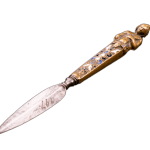Dutch enameler and monogrammed "C" blacksmith (both active in the first half of the 17th century)
A penknife with an enameled handle topped with a Bust of Bacchus, and with the monogram of the blacksmith ("C"), c. 1630
iron blade, brass and enamelled handle
16.7 x 2.1 x 1.2 cm
CHF 2'700.-
Further images
This delicate penknife (a small knife used to pierce food) features a remarkable handle adorned with champlevé enamel and topped with a beautiful Bust of Bacchus, identifiable by his attributes....
This delicate penknife (a small knife used to pierce food) features a remarkable handle adorned with champlevé enamel and topped with a beautiful Bust of Bacchus, identifiable by his attributes. Amusing details, such as the half-naked body, the grapes wrapping around his belly, or the clusters placed in front of his sex, convey the erotic character of Bacchus. As the god of pleasure, Bacchus is a popular motif in the iconography of the Dutch Golden Age, and the choice to crown the penknife with a Bust of Bacchus symbolizes joy and pleasure as well as prosperity and education, as mythological motifs were considered a sign of cultural refinement among the bourgeois and noble families of the 17th-century Netherlands. The artist who crafted the handle did not choose the representation by chance: the high society used such figurative cutlery during festivities. Moreover, the wear marks on the present penknife indicate an actual use, unlike the grand ceremonial cutlery.
Stylistic study and the most convincing comparisons place the creation of the knife in the Netherlands during the second quarter of the 17th century. Comparable enameling is found on a few examples only, all of Dutch origin. Notably, the two enameled cutlery handles from the Jacques Hollander (1940-2004) collection: one is topped with a Drummer Girl and the other one features a Bust of a Bagpiper. It can therefore be assumed that this type of knife handles originates from a workshop in the Netherlands, especially since another knife handle (now in the V&A, London) and classified as Dutch c. 1630, is practically identical to ours. The presence of this handle seems to signal the existence of a model with a Bust of Bacchus then circulating in the Netherlands.
On the blade of the present penknife, two valuable pieces information appear: the monogram "C" and the old inventory number "197". The monogram refers to the origin of the work and is generally a signature of a workshop, a family of blacksmiths or an individual blacksmith. The presence of this monogram is a quality criterion: only the guild members were entitled to their own monogram. The inventory number refers to the provenance of the present penknife and the historical cutlery collection of Achille Jubinal (1810-1875), important French medievalist and knight of the Legion of Honor who assembled an impressive eclectic collection. In 1873, Achille Jubinal's knife collection was lent and exhibited at the South Kensington Museum (predecessor of the V&A, London). The following year, the museum published a catalogue in which the present penknife was erroneously classified as Italian. The cutlery collection of Achille Jubinal was then privately kept in the same family for several generations before reappearing on the auction market, without having been identified as the former collection of Achille Jubinal.
We thank Flavio De Corso for his expertise.
Stylistic study and the most convincing comparisons place the creation of the knife in the Netherlands during the second quarter of the 17th century. Comparable enameling is found on a few examples only, all of Dutch origin. Notably, the two enameled cutlery handles from the Jacques Hollander (1940-2004) collection: one is topped with a Drummer Girl and the other one features a Bust of a Bagpiper. It can therefore be assumed that this type of knife handles originates from a workshop in the Netherlands, especially since another knife handle (now in the V&A, London) and classified as Dutch c. 1630, is practically identical to ours. The presence of this handle seems to signal the existence of a model with a Bust of Bacchus then circulating in the Netherlands.
On the blade of the present penknife, two valuable pieces information appear: the monogram "C" and the old inventory number "197". The monogram refers to the origin of the work and is generally a signature of a workshop, a family of blacksmiths or an individual blacksmith. The presence of this monogram is a quality criterion: only the guild members were entitled to their own monogram. The inventory number refers to the provenance of the present penknife and the historical cutlery collection of Achille Jubinal (1810-1875), important French medievalist and knight of the Legion of Honor who assembled an impressive eclectic collection. In 1873, Achille Jubinal's knife collection was lent and exhibited at the South Kensington Museum (predecessor of the V&A, London). The following year, the museum published a catalogue in which the present penknife was erroneously classified as Italian. The cutlery collection of Achille Jubinal was then privately kept in the same family for several generations before reappearing on the auction market, without having been identified as the former collection of Achille Jubinal.
We thank Flavio De Corso for his expertise.
Provenance
Executed c. 1630 in the Netherlands by an anonymous artist (who realized the enameled handle) and a blacksmith (who made the blade) who left his mark ("C").Paris, collection Achille Jubinal (1810-1875).
London, on loan (by the above) to the South Kensington Museum, in 1873 and most certainly until the collector's death.
Southern Germany, private collection, for several generations.
Switzerland, Koller Auktionen AG, March 21, 2024, lot 1648 (as "Dutch, second half of the 17th century").
Switzerland, private collection.
Exhibitions
Exhibited at:London, South Kensington Museum, 1873, n° 197 [A colleciton of ancien cutlery lent by M. Achille Jubinal to the South Kensington Museum].
Literature
Published in:Illustrated catalogue of a collection of ancient cutlery lent by M. Achille Jubinal to the South Kensington Museum, London, 1874, p. 20, n° 197.





